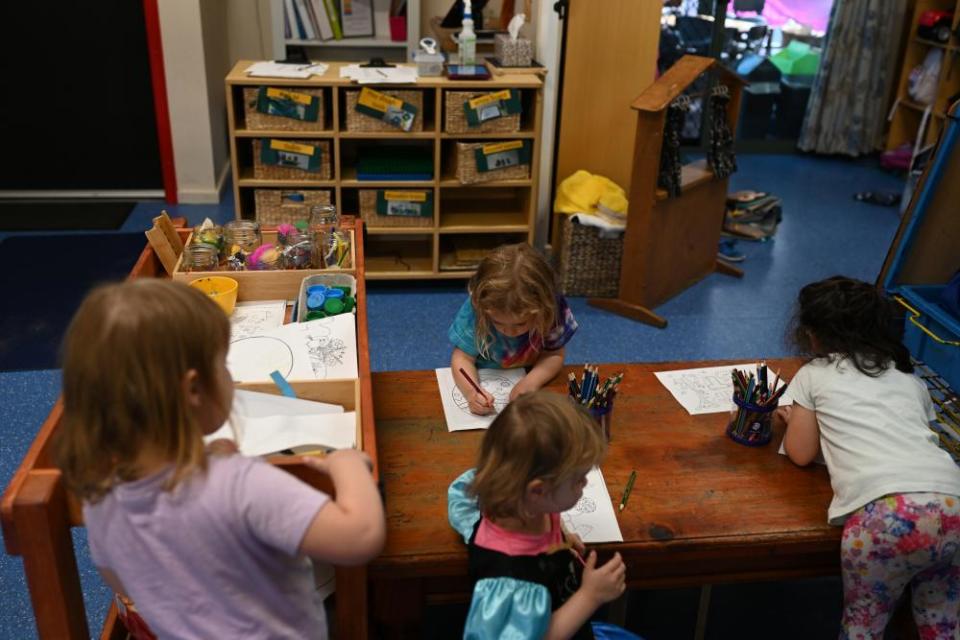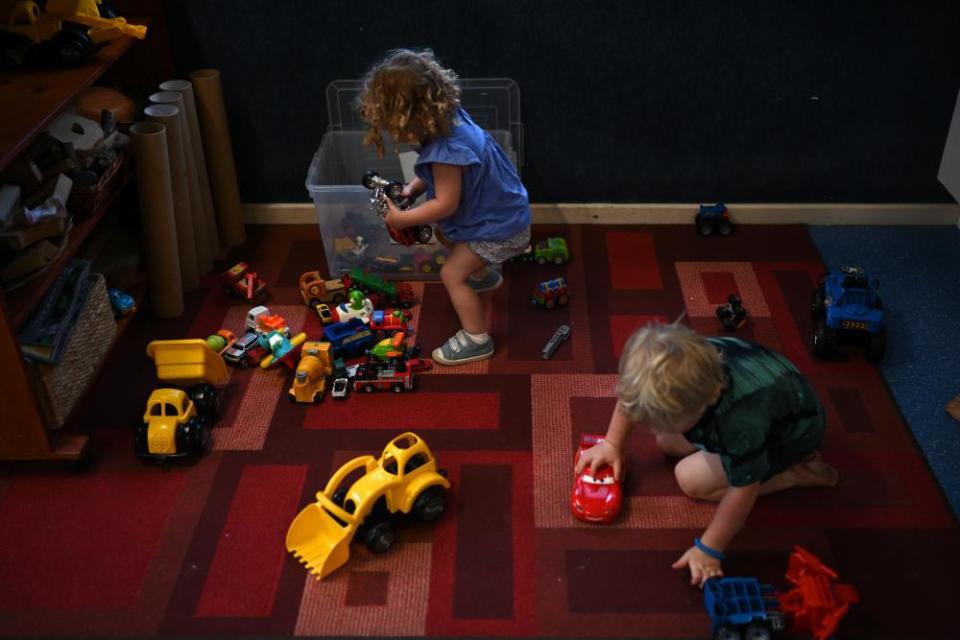'The hardest time in my life': how service providers shoulder the burden of free childcare
Tina Case paints a bleak picture when asked about the last two months at her family daycare service in Woy Woy on the New South Wales central coast.
Case has been driven to the point of near financial ruin. She’s had to defer car loans and rely on money from her sons to help pay off a home loan taken out just before the pandemic, all while providing more hours of care without any added pay.
Paradoxically, the source of her pain has not been Covid-19 itself, but the $1.6bn government package designed to save her.
“It’s been probably the hardest time in my life,” Case says. “The financial stress has just been so overwhelming.”
Case spoke to Guardian Australia just days after the education minister, Dan Tehan, proclaimed that the government’s support package for the childcare sector had “done its job … quite successfully” since its introduction in early April.
The package, an important part of the government’s overall coronavirus response, worked by giving operators 50% of the revenue they usually received, based on fees received in a fortnight in February, before the pandemic.
That measure was designed to work in tandem with the jobkeeper wage subsidy to keep services afloat, kids in childcare and parents at work.
In return, childcare providers were not allowed to charge parents fees and were required to remain open.
There is no doubting that, for many childcare services, the package has been a lifeline.
The government’s review of its first four weeks suggests 99% of the roughly 13,400 centres remained open as of 13 May.

A survey conducted just before the government’s announcement by peak group Australian Childcare Alliance, which represents the majority of the nation’s privately owned early learning services, found 30% were expecting to close due to falling occupancy rates caused by the pandemic.
For major corporates such as G8 Education, the announcement provided an immediate boost to share prices.
But the package also effectively forced other services to run at a loss, either because it was ill-suited to some segments of the childcare sector, such as small family daycare operators, or didn’t properly account for a highly casualised workforce with large numbers of workers on temporary visas, who were not eligible for jobkeeper.
Related: 'Free childcare has been amazing': Australian parents hope pandemic may pave way for reform
One-quarter of services surveyed in the four-week review of the scheme reported that it hadn’t helped them remain financially viable.
Case’s story is illuminating in understanding why.
When Covid-19 hit, she found herself providing vastly more hours of care for her children, not less. What was previously only before and after-school care suddenly turned into entire days for most of her children.
In normal circumstances, she would have taken in more fees from parents.
But the support package prevented her from doing so and, worse, entitled her only to 50% of the income she was receiving prior to the pandemic.
She felt she couldn’t turn children away, and doing so would have dragged parents out of the workforce, an outcome completely contrary to the scheme’s aims.
“There are three schoolchildren I’ve got that I don’t get paid for, so there’s hundreds if not thousands that I’m out of pocket on,” Case said. “But I still do it because they’re my families ... I do love what I do.”
She spent six weeks waiting for approval for jobkeeper. Case says she would have been better off without the government support package.
The scheme makes provision to pay extra for those in exceptional circumstances, including those who, like Case, have increased attendance.
But of the 168 applications for the exceptional circumstances supplementary payment made by family daycare providers, only 5% have been approved.
The rate is about 36% for centre-based care, and 75% for outside school hours care.
(June 1, 2020) What's due to end?
28 June – Free childcare: government pays 50% of usual support plus jobkeeper to centres. Cost: $1.6bn over three months, or roughly $131m a week
30 June – Instant asset write-off (must buy the asset and take delivery by 30 June). Unknown cost
(July 1, 2020) What's due?
13 July – Second (and currently last) economic support payment of $750 to 6.5m pensioners who do not receive extra Covid support under jobseeker. Cost: $8bn
(September 1, 2020) What's due to end?
25 September – Moratorium on bankruptcy, insolvency applications.
27 September – Jobkeeper. Cost: $70bn. Jobseeker $550 per fortnight boost. Cost of additional supplement $14.1bn
30 September – Cash flow boost for SMEs: eligible employers receive a credit of between $20,000 up to $100,000 for PAYG paid. Cost: $31.1bn. 50% support for apprentices’ wages. Cost: $1.3bn. SME loan guarantee scheme: government guarantees half of new unsecured loans to small and medium business up to $40bn worth of loans. No loan repayments will be required for the first six months of the loan. Applies to new loans made until 30 September. Cost unknown. Loan forbearance: banks allow small business and mortgage holders to defer and capitalise their obligations for six months on existing borrowings. Cost to banks unknown. Rental forbearance for SMEs receiving jobkeeper (mandatory code). Cost to landlords unknown.
In a submission to government this week, Family Day Care Australia said the system’s failings “have generated immense financial and emotional distress for a majority of family daycare educators and services”.
Chief executive Andrew Paterson said the support package is hampered by its inflexibility and its inability to recognise the differing circumstances and varying demand across the sector.
“The current funding framework does not support the higher levels of attendance that have been maintained in family daycare throughout the Covid-19 pandemic, nor does it support any capacity for growth,” Paterson told Guardian Austraia. “This is becoming increasingly problematic for the sector and for families as Covid-19 restrictions are wound back.”
Paterson and his members say the end of the support package cannot come soon enough.
They, along with others in the sector, are now preparing for what comes next.
Paul Mondo, the president of the Australian Childcare Alliance, predicts the next six weeks will pose an immense challenge to childcare operators.
Children will begin to return to care in increased numbers, he says, due to Australia’s remarkable recovery.
“[But] the limitations of the current arrangements will impact the number of children services can provide care for,” Mondo says.
The package was put in place for three months from April with an option to extend it for another three. The Coalition government has indicated the support is not likely to continue in its current form beyond 28 June.
That has concerned many, who warn the lingering economic crisis, coupled with a sudden loss of free childcare, will turn families away.
You can’t switch off free childcare on Friday and go back to childcare subsidy on Monday. That’s just not going to be possible.
Prue Warrilow
Unemployment continues to rise sharply, belts will keep tightening, and parents will soon face the prospect of somehow meeting childcare fees with no work or insecure work.
Prue Warrilow, the national convenor of not-for-profit peak group Australian Community Children’s Services, predicts the sector will struggle to maintain the occupancy rates needed to remain viable without ongoing government support.
“You can’t switch off free childcare on Friday and go back to [childcare subsidy] on Monday. That’s just not going to be possible,” Warrilow told Guardian Australia.
“The financial crunch is going to come in a six-to-nine-month period for many families, I think you’re going to see utilisation of children’s services decrease quite dramatically because families won’t be able to afford childcare unless there is a staged transition process.”
There are widely held fears in the sector about simply reverting back to the previous arrangements, which provided financial support to families for childcare in the form of the childcare subsidy (CCS).
Related: Work in progress: a $60bn miscalculation could make jobkeeper fairer and lead to quicker recovery
The CCS relies on an activity test, which pegs parents’ eligibility to the number of hours they work each week.
Such an approach would ignore the mass unemployment and lack of secure work Covid-19 has caused.
For a sector not without division, there is clear unity that the activity test must change dramatically or be suspended for the foreseeable future.
Mondo says it is “vitally important” that exemptions be made to the test to ensure children continue to receive care.
“We know that the government did consider and apply such exemptions during the bushfires earlier this year and have confidence that they are actively considering supporting families in this way as we transition out of the Covid crisis and into the economic one,” he said.

Lisa Bryant, an education and care advocate and consultant, also warns against relying on a work activity test at a time when 600,000 more people are unemployed across Australia due to Covid-19.
The consequences would be dire, both in terms of family access and provider viability, Bryant said.
“If a woman loses her job, then the child’s family is only able to get 16 hours of funded subsidy a week,” Bryant said. “For most services that means only one day a week. So if a family suddenly can only afford to get subsidised care for a day a week, and only one person is working, then they’re not going to be able to afford the four days that they used to have. So occupancy will fall dramatically.”
The government offers a temporary hardship payment to give additional subsidies to those struggling.
But the subsidy boost is generally only available for 13 weeks.
“We know that it’s going to be years before some people get their jobs back,” Bryant said.
Warrilow believes an effective solution would be to revert back to old arrangements that gave all families, regardless of their work activity, eligibility for two days of free childcare a week.
She said that would be the best way to help service operators and aid the most vulnerable of Australian families.
“The families that are not able to meet the work activity test, and because it’s a more generous test under CCS, are those that are really struggling. They don’t know how to do school volunteering, they don’t know how to be looking for work, so they’re long-term intergenerationally unemployed.
“By excluding those families we are exacerbating that problem. So if we had a minimum of two days for every family, that would make a significant difference to utilisation and service viability moving forward.”

 Yahoo News
Yahoo News 
